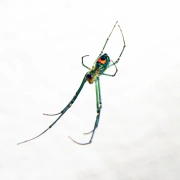Spiders: A few give the others a bad reputation
Take for example the green widow spider which gets a bad reputation from the black widow’s red hourglass shape. The fact is, this spider is an Orchard Orb Weaver or Orchard Spider and has nothing to do with the black widow.
The Orchard spider does not have a venomous bite and rarely bites.
We’ll explore the various types of spiders, their behavior, habitat, the importance of spiders in the ecosystem, their potential dangers, and their remarkable webs.
Types of Spiders
There are over 45,000 known species of spiders, and they come in all shapes and sizes. Spiders are classified based on their hunting behavior, method of catching prey, and web-building. Some of the most common types of spiders include:
- Orb-weaver spiders: These spiders are known for their intricate webs that they use to trap their prey. Orb-weaver spiders use their silk to spin large circular webs decorated with zigzagging silk bands. These webs can reach up to 2 meters in diameter.
- Jumping spiders: These agile and fast-moving spiders are known for their impressive jumping abilities. Jumping spiders hunt by jumping onto their prey and using their silk to create small anchor lines to stabilize themselves.
- Wolf spiders: These nocturnal hunters are known for their excellent eyesight. They hunt by stalking their prey and pouncing on them, often in burrows or under rocks. They do not build webs.
- Crab spiders: These spiders are ambush predators that do not build webs. They blend in with their surroundings and wait for prey to come within striking distance.
- Tarantulas: Large, hairy spiders that are often kept as exotic pets. Tarantulas are burrowing spiders that use their silk to create tubes and tunnels where they can hide.
Behavior and Habitat
Spiders are known for their predatory behavior and are crucial in controlling insect populations. They hunt using a variety of tactics, including trapping insects in their webs, ambushing them, and chasing them down. Spiders are found in a wide range of habitats, including forests, deserts, and even underwater.
Many spiders are solitary creatures, but some species live in groups. Social spiders often work together to build and defend their webs and care for their young. Some spiders, like the orb-weaver spider, will even rebuild their webs daily.
Importance in the Ecosystem
Spiders play a significant role in the ecosystem as they control insect populations, which would otherwise be overwhelming. They are also an important food source for many predators, including birds, lizards, and other spiders.
Without spiders, the world would be overrun by insects, which would devastate crops and the environment.
In addition, spiders have contributed significantly to scientific research. Scientists have studied spider silk for its incredible strength and potential applications in industries like medicine and textiles.
Potential Dangers from Bites
While the vast majority of spider species are harmless to humans, there are some that pose a potential danger. According to the American Association of Poison Control Centers, there were 2,514 reported cases of spider bites in the United States in 2020, with only 1.2% of those cases considered severe. Some of the most dangerous spiders include:
- Black Widow Spiders – Found throughout the world, these spiders have a distinctive red hourglass shape on their abdomen and can cause severe pain, muscle spasms, and even death.
- Brown Recluse Spiders – Found in the United States, these spiders have a violin-shaped marking on their head and can cause necrotic wounds.
- Sydney Funnel-Web Spiders – Found in Australia, these spiders are highly venomous and can cause respiratory failure.
It is important to note that most spider bites are not dangerous and will only result in minor swelling or itching. However, seek medical attention immediately if you are bitten by a spider and experience severe symptoms.
Remarkable Webs
Spiders are known for their remarkable webs, which they use for hunting and protection. Several types of spider webs exist, including orb webs, funnel webs, and sheet webs. Orb webs are the most common and are made by orb-weaver spiders. They are characterized by their circular shape and radiating lines that form a spiderweb pattern.
Spider silk is incredibly strong and can be used to create a variety of items. Scientists have studied spider silk for its potential applications in industries such as medicine and textiles. Some researchers have even looked at the possibility of using spider silk as a material for bulletproof vests.
Spiders are Important
Spiders are essential to the natural world and deserve our respect and appreciation. With their diverse range of behaviors and habitats, spiders are fascinating creatures that have contributed significantly to scientific research.
While some species can pose a potential danger to humans, most spiders are harmless and play a crucial role in maintaining the ecosystem’s delicate balance.
